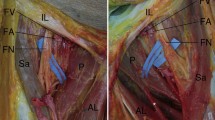Summary
The topography of different muscles in the erector spinae muscle at different lumbar levels was studied by serial cutting as well as by dissections in 21 subjects. The lumbar part of the erector spinae muscle is subdivided into a medial muscle compartment, the transversospinalis compartment, and a lateral muscle compartment, the sacrospinalis compartment. The former contains mainly the multifidi muscles, the latter chiefly being made up of the longissimus and the iliocostalis muscles. The different muscles and parts of muscles within the transversospinalis compartment are interwoven in such a way that it is difficult to separate them from each other. The longissimus and the iliocostalis muscles are posteriorly but usually not anteriorly separated from each other in the lumbar spine.
It is assumed that it is possible to study the multifidi, the longissimus and the iliocostalis muscles at different lumbar levels with present electromyographic methods. Two techniques for insertion of EMG electrodes into these muscles at different lumbar levels are suggested. The techniques are based on the assumption that the insertion can be guided either by fluoroscopy or by palpation only.
Similar content being viewed by others
References
Eisler, P.: Handbuch der Anatomie des Menschen, Bd. 2, Abt. 2, Teil 1, Die Muskeln des Stammes. Jena: G. Fischer 1912.
Etemadi, A. A.: Observations on the musculature and innervation of the human back. M. Sc. Thesis, London University, 1963.
Eycleshymer, A. C., Schoemaker, D. M.: A cross-section anatomy. New York: D. Appleton-Century Company 1911 (reprinted 1938).
International Anatomical Nomenclature Committee: Nomina anatomica. Amsterdam: Excerpta Medica Foundation 1966.
Jonsson, B., Bagge, U. E.: Displacement, deformation and fracture of wire electrodes for electromyography. Electromyography 8, 329–347 (1968).
—, Reichmann, S.: Displacement and deformation of wire electrodes in electromyography. Electromyography 9, 201–211 (1969).
Lewin, T., Moffett, B., Viidik, A.: The morphology of the lumbar synovial intervertebral joints. Acta morph. neerl.-scand. 4, 299–319 (1962).
Morris, J. M., Benner, G., Lucas, D. B.: An electromyographic study of the intrinsic muscles of the back in man. J. Anat. (Lond.) 96, 509–520 (1962).
Pauly, J. E.: An electromyographic analysis of certain movements and exercises. I. Some deep muscles of the back. Anat. Rec. 155, 223–234 (1966).
—, Steele, R. W.: Electromyographic analysis of back exercises for paraplegic patients. Arch. phys. Med. 47, 730–736 (1966).
Reichman, S., Jonsson, B.: Contrast radiography with carbon dioxide for the location of intramuscular EMG electrodes.Electromyography 7, 103–124 (1967)
Author information
Authors and Affiliations
Rights and permissions
About this article
Cite this article
Jonsson, B. Topography of the lumbar part of the erector spinae muscle. Z. Anat. Entwickl. Gesch. 130, 177–191 (1970). https://doi.org/10.1007/BF00518805
Received:
Issue Date:
DOI: https://doi.org/10.1007/BF00518805




